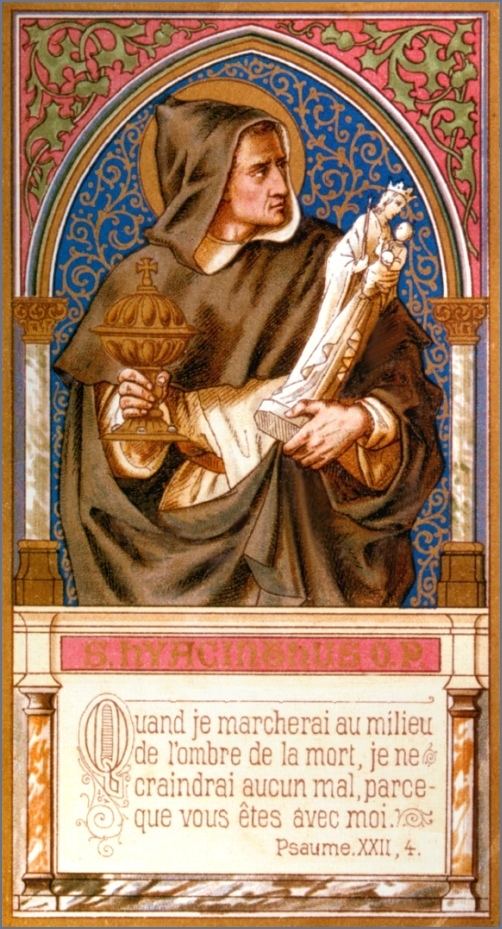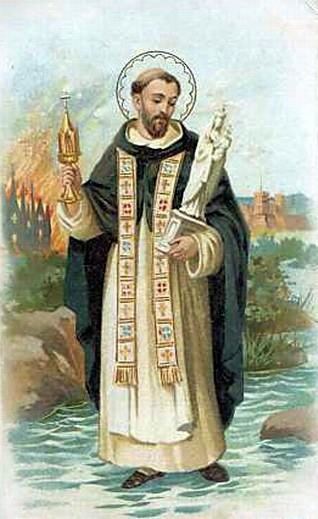Feast 17 August | Name Hyacinth Poland | |
 | ||
Venerated in Roman Catholic Church, Aglipayan Church Attributes statue of the Blessed Virgin Mary; Monstrance or uCiborium Similar People Stanislaus of Szczepanow, Albert Chmielowski, Jadwiga of Poland, Faustina Kowalska, Zygmunt Szczesny Felinski | ||
St hyacinth of poland 2
Saint Hyacinth, O.P., (Polish: Święty Jacek or Jacek Odrowąż) (b. ca. 1185 in Kamień Śląski (Ger. Groß Stein) near Opole (Ger. Oppeln), Upper Silesia – d. 15 August 1257, in Kraków, Poland of natural causes) was educated in Paris and Bologna. A Doctor of Sacred Studies and a regular priest, he worked to reform women's monasteries in his native Poland.
Contents

St hyacinth of poland 2010 2011
Life

Called the "Apostle of the North", Hyacinth was the son of Eustachius Konski of the noble family of Odrowąż. He was born in 1185 at the castle of Lanka, at Kamin, in Silesia, Poland. A near relative of Blessed Ceslaus, he made his studies at Kraków, Prague, and Bologna, and at the latter place merited the title of Doctor of Law and Divinity. On his return to Poland he was given a prebend at Sandomir. He subsequently accompanied his uncle Ivo Konski, the Bishop of Kraków, to Rome.

While in Rome, he witnessed a miracle performed by Saint Dominic, and became a Dominican friar, along with the Blessed Ceslaus and two attendants of the Bishop of Kraków - Herman and Henry. In 1219 Pope Honorius III invited Saint Dominic and his followers to take up residence at the ancient Roman basilica of Santa Sabina, which they did by early 1220. Before that time, the friars had only a temporary residence in Rome at the convent of San Sisto Vecchio which Honorius III had given to Dominic circa 1218, intending it to be used for a reformation of Roman nuns under Dominic's guidance. Hyacinth and his companions were among the first to enter the convent. They were also the first alumni of the studium of the Dominican Order at Santa Sabina out of which would grow the 16th century College of Saint Thomas at Santa Maria sopra Minerva, which became the Pontifical University of Saint Thomas Aquinas, Angelicum in the 20th century. After an abbreviated novitiate, Hyacinth and his companions received the religious habit of the Order from St. Dominic himself in 1220.

The young friars were then sent back to their homeland to establish the Dominican Order in Poland and Kiev. As Hyacinth and his three companions traveled back to Kraków, he set up new monasteries with his companions as superiors, until finally he was the only one left to continue on to Kraków. Hyacinth went throughout northern Europe spreading the faith. He died in the year 1257. Tradition holds that he also evangelized throughout Sweden, Norway, Denmark, Scotland, Russia, Turkey, and Greece. However, these travels are heavily disputed and are not supported by the earliest lives of St. Hyacinth.
Legend

One of the major miracles attributed to Hyacinth came about from a Mongol attack on Kiev. As the friars prepared to flee the invading forces, Hyacinth went to save the ciborium containing the Blessed Sacrament from the tabernacle in the monastery chapel, when he heard the voice of Mary, the mother of Jesus, asking him to take her, too.
Hyacinth lifted the large, stone statue of Mary, as well as the ciborium. He was easily able to carry both, despite the fact that the statue weighed far more than he could normally lift. Thus he saved them both. For this reason he is usually shown holding a monstrance (though they did not come into use until several centuries later), and a statue of Mary.
"Święty Jacku z pierogami!" (St. Hyacinth with pierogi!) is an old-time saying, mentioning call for help in some hopeless circumstances. It has derived from two legends. One of them is about his visit on July 13, 1238 to Kościelec. During his visit a hailstorm broke out, destroying crops and leaving people with a specter of poverty and famine. Hyacinth told them to pray. Next day crops have risen. People have treated Hyacinth with pierogi made from those crops as a token of gratitude. Second legend mentions Hyacinth feeding people with pierogi during famine caused by Tatars invasion in 1241
Veneration
Hyacinth was canonized on 17 April 1594 by Pope Clement VIII, and his memorial day is celebrated on 17 August. In 1686 Pope Innocent XI named him a patron of Lithuania. He is the patron saint of those in danger of drowning.
In Spanish-language countries, Hyacinth is known as San Jacinto. However, most of the numerous towns and locations in Spanish-speaking countries that are so named are named for Hyacinth of Caesarea.
Among churches dedicated to Hyacinth of Poland is St. Hyacinth's Basilica in Chicago, Illinois.
He is also the patron saint of the Ermita de Piedra de San Jacinto in the Philippine city of Tuguegarao, where his feast day is celebrated with a procession and folk dance contests.
The town of Camalaniugan in the Philippines is also under the said saint's patronage. The town church dedicated to San Jacinto or Saint Hyacinth is home to the oldest church bell (the Sancta Maria 1595) in the Far East.
The town of San Jacinto de Yaguachi, near Guayaquil in Ecuador, has had Saint Hyacinth as its patron saint since the 15th century. There is a cathedral in the town dedicated to the saint, which holds relics of St. Hyacinth given to the Archbishop of Guayaquil by Pope John Paul II in the 1980s.
He is the patron saint of the parish in Deer Park, Texas.
